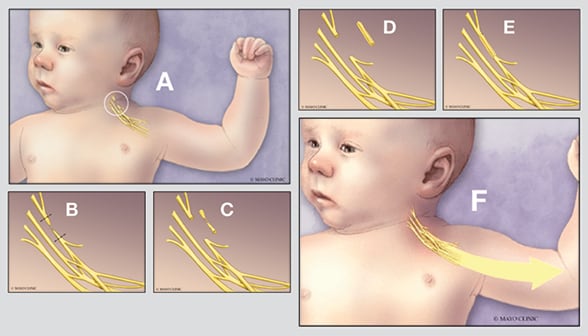Jan. 11, 2019
The brachial plexus injuries experienced by newborns can range from a few stretched nerves to the tearing or rupturing of all nerves in the brachial plexus network. A multidisciplinary approach is beneficial to achieving optimal outcomes.
The brachial plexus clinic at Mayo Clinic, which manages care for children and adults, is one of the highest-volume brachial plexus clinics in the country. The treatment team includes two orthopedic hand and microsurgeons, as well as a pediatric orthopedic surgeon and a neurosurgeon specializing in peripheral nerve surgery. Subspecialized radiologists and anesthesiologists with experience in diagnostic and surgical procedures for these young patients also are available.
Appointments for patients with these injuries are generally made within a week or two of referral. Ideally, the required nerve surgery should be performed early, to avoid muscle degeneration due to the lack of nerve signals.
"We know that if you wait too long for that initial surgery — just observing for the baby's first year — you can lose the ability to do primary nerve surgery. Typically, the nerves need to be operated on in the first six months of life," says Alexander Y. Shin, M.D., an orthopedic hand and microsurgeon specializing in brachial plexus injuries at Mayo Clinic Children's Center in Rochester, Minnesota.
The benefits of an integrated approach can be seen throughout the process of managing neonatal brachial plexus injuries. Diagnosis generally involves MRI and nerve tests. At Mayo Clinic, pediatric neurologists, radiologists and anesthesiologists coordinate to perform testing in one setting.
"Otherwise, a baby might end up having two or three major anesthesia procedures. We try to minimize anesthesia to one when possible," Dr. Shin says.
Cirugía neonatal por lesión del plexo braquial

Cirugía neonatal por lesión del plexo braquial
La ilustración muestra lo que ocurre durante la cirugía neonatal por lesión del plexo braquial. A. El plexo braquial está ubicado en el cuello por encima de la clavícula. B. El segmento dañado y el nivel de lesión se identifican en la cirugía. C y D. El segmento dañado se retira y luego se lo reconstruye tomando segmentos de injerto de nervio de la pierna y agrupándolos en cable para que coincidan con el tamaño del nervio dañado. E y F. El injerto de nervio en cable se cose en su lugar mediante microcirugía, lo que permite que el nervio se regenere para restaurar la función de los músculos paralizados.
Having a multidisciplinary team allows for surgical reconstruction that is tailored to the individual patient's needs — nerve surgery, tendon transfers and shoulder-to-hand reconstruction — when necessary. Dr. Shin notes that brachial plexus nerve surgery can restore 70 to 80 percent of shoulder and elbow function in certain types of injury. However, imbalances in growth from nerve injury around the shoulder can lead to secondary sequelae: typically, internal retraction contracture and the inability to externally rotate the shoulder.
"If those sequelae aren't addressed before about 2 years of age, the child might experience long-term problems, especially with the shoulder," Dr. Shin says. About 70 to 80 percent of patients who need secondary surgery have good outcomes.
"A baby having a brachial plexus injury can understandingly be an emotional experience for parents," Dr. Shin says. "Our brachial plexus team works together so that parents and baby can move forward with the best possible care."